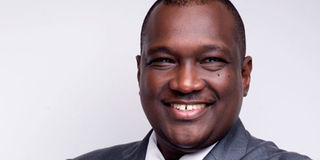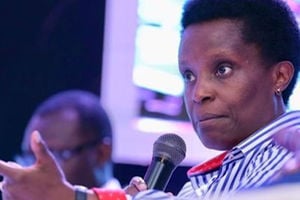Future of budgeting, financial forecasting

Patrick Adengo
What you need to know:
- CFOs, senior management and leaders alike are adopting next-generation planning capabilities to capitalize on data availability, drive strategic decision-making in real time, and support everyday business decisions.
Automated financial forecasting means faster time to insights and decisions, which is critical to leading organizations through today’s complex environments and into planning for the future. Achieving it, however, requires an end-to-end strategy. By discovering a framework that can guide you on the path to making that future a reality today.
The future of digital products, experiences, and services is upon us. Companies' commercial departments are rapidly digitizing and creating an immense amount of data that’s available to support planning, reporting, and analytics. The future of forecasting is being transformed through technology to create an environment in which people work symbiotically with data-fueled predictive algorithms to deliver forecasts, discover insights, and act with more confidence and speed.
Chief Financial Officers (CFOs), senior management and leaders alike are adopting next-generation (next-gen) planning capabilities to capitalize on data availability, drive strategic decision-making in real time, and support everyday business decisions.
What does automated financial forecasting look like in practice?
Quarterly forecasts and annual planning submissions are all too familiar for both financial analysts and senior leaders. Imagine an organization where the churn and extensive hours behind these forecast submissions do not exist. The reason for this is not because the CFO has a crystal ball to predict, but because there is a continuous, real-time forecast that incorporates continuous data feeds of financial, operational, and third-party data:
- Movements in key drivers trigger updates to forecasts in real time.
- Automated data flows capture these movements to update algorithmic models forecasting each financial statement.
- Real-time variance analysis and driver analytics allow leaders to understand the why of an evolving forecast.
- Connected planning environments ensure affected drivers are linked and modeled consistently across functions and financial statements.
- Business partners and finance alike are promptly notified and operate within an integrated framework to quickly take strategic and operational action.
This may seem far-fetched, but the combination of cloud infrastructure, modern APIs, digital data generation, and redefined talent models can help bring your organization to an automated financial forecasting future.
What does the journey to execution look like?
Achieving a state of automated financial forecasting does not happen overnight. It is important to take an end-to-end approach to data management, process design, and talent. The thoughtful design of integration across each of these is critical to enabling automated financial forecasting and delivering real and sustainable value to your organization.
A step-by-step framework to guide your organization is shared below;
i) Data management:
Automated financial forecasting starts by building the data foundation to support all finance processes. Advanced algorithmic models and organization-wide analytics tools require high-quality data. Automated processes require those data feeds on a continuous basis.
To achieve this state of continuous data flow, it is imperative for organizations to establish data quality and data management governance models with transparency, flexibility, and evolving standards as new data is introduced and old data is better understood. The key is to establish data in a common information model that allows various systems and tools to efficiently publish and subscribe in the same language. Machine learning, natural language processing, and advanced analytics tools can all source from high-quality information models proactively, producing insights and identifying connections across various organizational datasets off the backbone of a high-quality, rules-based, and structured data model. A purposeful data foundation enables effective and efficient analytics, whereas bad data equates to poor analytics and inefficient processes.
ii) Next-generation (Next-gen) planning process:
The process behind automated financial forecasting is focused on collecting the right data at the right time to drive advanced modeling techniques and enable humans and machines to cohesively provide insights on a continuous basis. That starts with effective data-capture processes that deliver useful data to be leveraged by advanced algorithmic models, machine learning, and AI tools.
Finance organizations must proactively partner with other functions to capture relevant and useful data across the product life cycle continuum to effectively inform financial models. Machine learning and AI tools will actively assess data feeds and identify “best-fit” algorithms in real time to generate a more accurate forecast on a continuous basis. Users then interact with the models to provide human input and apply strategic decisions in real time.
iii) Workforce and talent:
For organizations to achieve a state of automated forecasting, solving for data requirements and process capabilities may pose less of a challenge than creating an organization with a data-centric mindset focused on teaming cohesively with machines.
Finance must become more comfortable pioneering new ideas to create and challenge data-driven hypotheses. Intense curiosity should drive Finance talent to better understand the business processes they quantify, advocate for and explain the predictive models they design, and drive continuous improvement of the organizational data landscape. Functional finance expertise alone is already table stakes for the finance workforce and is not enough. In order to architect a finance function to achieve continuous forecasting, it is critical for the CFO to instill a bias for data-based decisioning, continuous improvement of predictive models, and a passion for technology enablement.
What’s the value of automated financial forecasting?
Automated financial forecasting puts data, reporting, and analytics at the fingertips of business leaders to effectively operate in demanding business environments. For CFOs, this means faster time to insights and decisions that drive earnings, reduce costs, and create controls over financial outcomes. For business leaders, this means more transparency into forecasts and assumptions to execute better pricing, predict customer demands, and reduce working capital.
Across the organization, both analysts and senior management will have access to real-time analytics and scenario models to inform everyday decisions. Processes will become more efficient through enabling technology and digital capabilities to keep organizations focused on delivering future value versus reconciling data and reporting on what has already happened.
Critical success factors
End-to-end strategy and design: Concentrate design efforts across data management, process design, and workforce and talent to create the connectivity required across functions, systems, and tools to enable an automated forecasting environment.
User adoption: Build trust in machine-powered, automated forecasting to drive adoption and incorporation of these powerful tools within everyday ways of working.
Human-centric design: Focus design efforts on the end user to better align machine-enabled forecast capabilities with the intended process and forecast outputs.
Focus on data: Don’t underestimate the importance of a solid and complete data foundation to support a state of automated financial forecasting.
Executive leadership support: Establish top-down leadership support to drive commitment and focus from the organization to realize the value of automated financial forecasting.
Realizing the future of financial forecasting
Automated financial forecasting requires an end-to-end strategy across data management, process design, and workforce and talent. The future of forecasting will be enabled by humans and machines working together cohesively with continuous, reliable data feeds to deliver timely insights that drive valuable, data-driven decisions for organizations to quickly and efficiently navigate complex environments.
Talent and workforce models across industries are already adapting to these future ways of working. For CFOs, automated financial forecasting means real-time analytics and real-time decision-making. This is especially important as companies navigate unprecedented times and complex competitive environments.
The author, Patrick O. Adengo is director at Stalworth Consulting Group, LLC, management consultancy, digital strategy and technology advisory.
[email protected]




